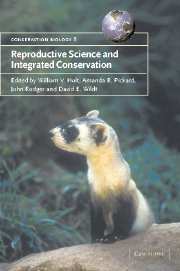Book contents
- Frontmatter
- Contents
- List of contributors
- Foreword
- Part I Introduction
- Part II Reproduction and population viability
- Part III Reproductive techniques for conservation management
- Part IV Integrated conservation management
- 14 Integrating reproductive sciences into recovery programmes for declining and extinct marsupial populations
- 15 Captive breeding and predator control: a successful strategy for conservation in Western Australia
- 16 Black-footed ferret: model for assisted reproductive technologies contributing to in situ conservation
- 17 Genetic resource banks for species conservation
- 18 Fertility control for wildlife
- 19 Contraceptive vaccine development
- 20 Field applications of fertility control for wildlife management
- Part V Reproduction science in non-mammalian species
- Part VI Conclusions
- Index
- References
15 - Captive breeding and predator control: a successful strategy for conservation in Western Australia
Published online by Cambridge University Press: 21 January 2010
- Frontmatter
- Contents
- List of contributors
- Foreword
- Part I Introduction
- Part II Reproduction and population viability
- Part III Reproductive techniques for conservation management
- Part IV Integrated conservation management
- 14 Integrating reproductive sciences into recovery programmes for declining and extinct marsupial populations
- 15 Captive breeding and predator control: a successful strategy for conservation in Western Australia
- 16 Black-footed ferret: model for assisted reproductive technologies contributing to in situ conservation
- 17 Genetic resource banks for species conservation
- 18 Fertility control for wildlife
- 19 Contraceptive vaccine development
- 20 Field applications of fertility control for wildlife management
- Part V Reproduction science in non-mammalian species
- Part VI Conclusions
- Index
- References
Summary
INTRODUCTION AND OBJECTIVES
The ultimate goal for captive breeding programmes must be to reintroduce animals to the wild; however, the value of a captive breeding programme is limited if there is no available habitat. Processes threatening native fauna in Australia include loss of habitat from clearing and land degradation, fragmentation of habitat, introduction of domestic stock, introduction of competitors such as rabbits, and predation by foxes and cats (www.environment.gov.au/bg/wildlife/lists/ktp/index). Many of these processes are threats to wildlife anywhere in the world, but integrated ex situ and in situ conservation programmes in Australia face an unusual habitat management issue, namely the control of introduced predators, in particular foxes and cats. There have recently been major successes where conservation reintroduction programmes have been linked with predator control. Three Western Australian mammal species (woylie, tammar wallaby and quenda) have been removed from State and National Threatened Fauna lists (see http://www.biodiversity.environment.gov.au/wildlife/lists/anzecc/index) as a result of broad-scale fox control and translocations carried out as part of the Western Shield Fauna Recovery Programme of the Western Australia Department of Conservation and Land Management (CALM). Perth Zoo and CALM are working collaboratively to achieve similar outcomes with a range of threatened species. In this chapter we aim to demonstrate the principles involved in this conservation strategy, as readers may be unfamiliar with the dual concept of controlling one wild population to protect another.
- Type
- Chapter
- Information
- Reproductive Science and Integrated Conservation , pp. 232 - 248Publisher: Cambridge University PressPrint publication year: 2002

